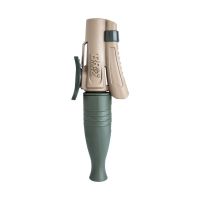It’s easy to think that once the rut is in full swing you ought to be spending every possible waking moment on stand. While this certainly may be a valid argument, does it mean that you should sit your best stand day in and day out? Some believe it’s impossible to burn out a rut stand simply because the bucks are rut-crazed and mentally checked out. Is there any truth to this belief?
Stands You Can Burn Out While comparing notes with whitetail fanatic Alex Gyllstrom, we came to the conclusion that you absolutely can overhunt your favorite rut stand.
“When the rut finally arrives, it can be easy to lose sight of the details that really matter,” Gyllstrom said. “Just because you've left that special rut stand untouched all season doesn't mean that it's bulletproof. If you're not careful, you can spend the rut watching squirrels instead of bucks.”
Certain setups are more prone to overhunting than others. Locations with difficult access or swirling winds are the most susceptible. Consider a classic rut-hunting setup: deep in the timber near bedding areas. During your long trek through the thick stuff you’re far more likely to bump a deer or two on the way in than you would near a field edge with easy access.
“For me, stand locations are all about access, whether we’re in the rut or not,” Gyllstrom said. “If the access isn't great, you're only going to get one, maybe two sits before a mature buck is on to you. Just because he's frothy-mouthed and wide-eyed like a zombie doesn't mean he's completely oblivious to your presence.”
Every deer that becomes clued into your presence has a compounding effect on how many deer you see over the span of the rut. Spook the does out of the area one at a time, and bucks will take note and transition to where the does have relocated.
Stands You Can’t Burn Out The setups you can hunt repeatedly all have easy access that you can use time after time and remain undetected. These spots typically have short commutes or ones that pass through areas that deer don’t inhabit for long periods of time. One example is a transition area like the classic rut funnel, where bucks simply cruise through and get bottlenecked by a pinch-point feature.
“Rarely will you find that golden spot where you can enter and exit without a trace,” Gyllstrom said. “These are amazing locations because you can get away with hunting them repeatedly. If you can find a great rut spot that allows great access, don't hesitate to go all-in on it for as long as the wind allows.”
Another stand type that I frequently employ is a quick-stop water source where deer snag a drink and continue on their merry way. I’ve heard many whitetail gurus claim they’d rather hunt a B-grade spot where they never get busted than an A-grade spot where they’ll likely spook a deer or two every hunt.
Gyllstrom advocates for a rut setup near a mix of habitats with what he refers to as a “guarded side” to avoid getting busted.
“This can be a thick CRP patch bordered by timber or high-stem-count cover, and the guarded side can be a deep ditch, creek bottom, or open field,” Gyllstrom said. “The goal is to position yourself in a place where upwind movement is funneled in front of you, while your downwind is carried out behind you, ideally having no effect on deer activity.”
Like many things in life, taking a blended approach can be a wise move. When your hunt is down to the wire and your season is coming to a close, swing for the fences and hunt those high-risk, high-reward spots. Alternatively, if you’ve only got a few locations to choose from, diving into a high-risk spot on day one of a seven-day hunt can make for a long week.
My rut strategy is to find a few quality stand locations that I can hunt to death, coupled with go-for-broke stand locations matched with each possible wind direction. Regardless of your hunting situation, be careful to not fall victim to a burned-out rut stand by giving yourself plenty of options.





